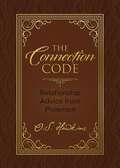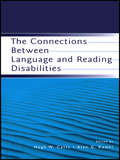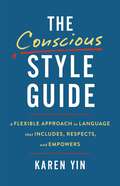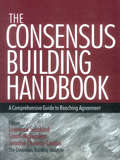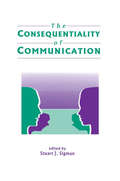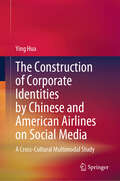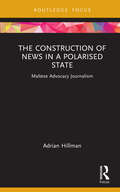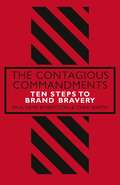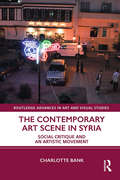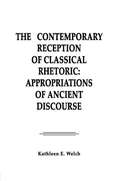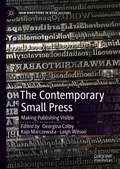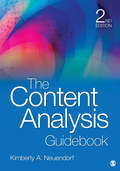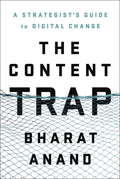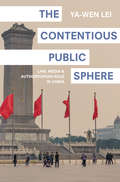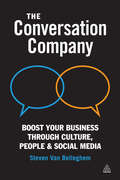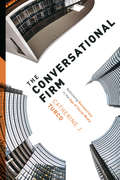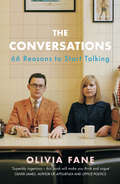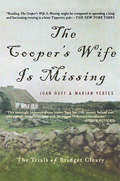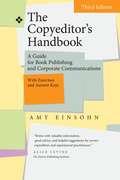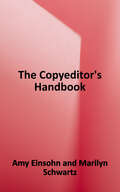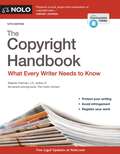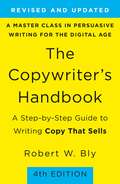- Table View
- List View
The Connection Code: Relationship Advice from Philemon (The Code Series)
by O. S. HawkinsWe have all experienced disappointment in relationships. Sometimes we wonder if it's even possible to have enduring, positive relationships in our homes, our work, and our communities.In The Connection Code, trusted Bible teacher O. S. Hawkins digs deep into the biblical book of Philemon to give us a blueprint for building life-giving relationships in every sphere of our lives. This tiny book in the New Testament is a letter the apostle Paul wrote to a wealthy businessman named Philemon on behalf of his escaped bond servant, Onesimus. Containing only 22 sentences, the book of Philemon unlocks the code to forging interpersonal connections that stand the test of time.With the practical and thoughtful Bible teaching he's known for, Dr. Hawkins reflects on every verse in Philemon in light of our relationships today. Following the style of the bestselling Code Series, The Connection Code explores:The three critical relationships each of us needHow to let others know we believe in themWhy a win-win perspective is crucial for friendshipsHow true commitment always includes forgivenessWhy finding our self-worth in Christ empowers us to love others well If you long for deep, authentic friendships in a superficial world, discover what God's plan has always been for building relationships that last in The Connection Code.
The Connections Between Language and Reading Disabilities
by Alan G. Kamhi Hugh W. CattsThis is an edited book based on papers presented at a 2003 invitee-only conference under the sponsorship of the Merrill Advanced Studies Center of the University of Kansas. The participants were prominent scholars in the areas of language and reading, and have research programs funded by NIH and other sources. The purpose of the gathering was to discuss theoretical issues and research findings concerning the relationship between developmental language and reading disabilities, specifically looking at neurological, behavioral, and genetic factors. In addition, it discussed other factors contributing to reading difficulties in the middle elementary school years through adolescence and literacy outcomes for children with early language impairments, and how these problems relate to children with dyslexia. The Foreword is written by Reid Lyon, Branch Chief, Child Development and Behavior Branch, NICHD-National Institutes of Health.This book appeals to scholars in the areas of language disorders and reading disabilities, as well as to practicing speech-language pathologists, special educators, and reading specialists. It may also be used in graduate courses designed as seminars in either language disorders or reading disabilities in schools of communication disorders, as well as schools of education--especially special education departments.
The Conscious Style Guide: A Flexible Approach to Language That Includes, Respects, and Empowers
by Karen YinA timeless, indispensable guide for anyone who wants to communicate with sensitivity and compassion. Most of us want to choose inclusive, respectful, and empowering language. But language—and how we use it—continually evolves, along with cultural norms. When contradictory opinions muddle our purpose, how do we align our word choices with our beliefs? Who has the final say when people disagree? And why is it so hard to let go of certain words? Afraid of getting something wrong or offending, we too often treat words as dos or don&’ts, regardless of context and nuance. Thankfully, in The Conscious Style Guide, award-winning editor Karen Yin provides a road map for writing and speaking with equity in mind—no matter how the world around us changes. Readers will learn: How to identify biased language How to use inclusive language to bring attention to specific groups of people How to adopt conscious language as a tool for self-awareness and critical thinking How to make digital materials more accessible, from event flyers to websites How to alleviate the stress of experiencing exclusionary language How to collaborate with others and work across differences How to create a style sheet to help support your practice And much more With practical advice and hundreds of relatable examples, The Conscious Style Guide invites us to challenge binary thinking, embrace flexibility and creativity, and explore truly effective communication—in all aspects of our lives.
The Consensus Building Handbook: A Comprehensive Guide to Reaching Agreement
by Sarah McKearnen Jennifer Thomas-Lamar Lawrence E. SusskindWhether you work in the corporate world, a nonprofit organization, or the government sector, you likely face the need to work with others to solve problems and make decisions on a daily basis. And you′ve undoubtedly been frustrated by how laborious and conflict-ridden such group efforts can be. At all levels – from neighborhood block associations to boards of directors of multinational corporations – the consensus building process is highly effective in an increasingly fragmented, contentious society. In addition, the old top-down methods such as Robert′s Rules of Orders often prompt more problems then they solve. Consensus helps you to implement better, more creative solutions. It provides a winning alternative to top-down decision making – and even parliamentary procedure. By learning to build consensus, stakeholders come to understand and respect one another′s perspectives. The consensus building process allows participants to find solutions and forge agreements that meet everyone′s needs – and provides a meaningful basis for effective, long-range implementation of decisions. The Consensus Building Handbook provides a blueprint to help make the process work in your organization, including a practical, quick-reference Short Guide. Plus, you′ll find in-depth commentary and seventeen case studies with in-depth commentaries to provide the theoretical basis for this new approach. CASE STUDIES INCLUDE: Activating a Policy Network: The Case of Mainport Schiphol The Northern Oxford County Coalition: Four Maine Towns Tackle a Public Health Mystery The Chelsea Charter Consensus Process Resolving Science-Intensive Public Policy Disputes: Reflections on the New York Bight Initiative Negotiation Superfund Cleanup at the Massachusetts Military Reservation RuleNet: An Experiment in Online Consensus Building Regulatory Negotiations: The Native American Experience The Chattanooga Process: A City′s Vision Is Realized From City Hall to the Streets: A Community Plan Meets the Real World The Catron County Citizens Group: A Case Study in Community Collaboration Facilitating Statewide HIV/AIDS Policies and Priorities in Colorado Building Consensus for Change Within a Major Corporation: The Case of Levi-Strauss & Company
The Consequentiality of Communication (Routledge Communication Series)
by Stuart J. SigmanIn a bold attempt to redirect the ways theories of communication are conceived and research on communication processes are conducted, this volume questions prevailing communication scholarship that emphasizes the cultural, psychological, and sociological variables that impact on, and/or are impacted by, communication. Instead of focusing on the consequences of communication, this books urges readers to examine the consequentiality of communication -- what it is about the communication process that enables it to play a defining role in our lives. Communication is not a neutral conveyor of meanings derived from culture, cognition, or social structure, and is not explained by correlations with external variables. Meaning emerges from the communication process itself; it is dependent upon what transpires during the real-time moments of communicators behaving with each other. To properly study this new paradigm, a new vocabulary for thinking about the consequentiality of communication is needed and proposed. Four theoretical orientations are used to stake out this new territory: coordinated management of meaning, neo-rhetorical theory, conversation analysis, and social communication theory. While there are points of agreement and overlap on the need to study communication as inherently consequential, there are also differences across the four theories -- in the value of "rules" as an explanatory concept, on the relationship between structure and process, and on the very constitution of a "theory." Thus, this book has the benefit of articulating a new paradigm for communication scholarship without losing sight of the discipline's rich diversity.
The Construction of Corporate Identities by Chinese and American Airlines on Social Media: A Cross-Cultural Multimodal Study
by Ying HuaUsing top Chinese and American airlines as examples, this book approaches the construction of corporate identities on social media, a critical issue in corporate communication, from a cross-cultural multimodal perspective. Through a holistic and systematic multimodal analysis, it provides a comprehensive cross-cultural understanding of corporate identity construction on social media. By developing an integrated social semiotic framework based on registerial cartography in SFL, it investigates the airlines’ registerial activity patterns in terms of macro-level configuration and micro-level multimodal realizations, interprets their situated contextual patterns that delineate the construction of corporate identities and further explains the influence of cultural factors. Given that this book offers theoretical contributions to corporate identity and cross-cultural communication research, practical guidance on PR practices, especially in the context of Chinese enterprises going global, and pedagogical insights for business communication courses, this book will be of particular benefit to researchers in linguistics, management and communication studies, PR practitioners, and both lecturers and learners of business communication courses.
The Construction of News in a Polarised State: Maltese Advocacy Journalism (Routledge Focus on Communication and Society)
by Adrian HillmanTaking a qualitative approach based on original case studies, this book offers a detailed overview of the contemporary media system in Malta. Three Maltese news organisations are examined to understand the editorial routines, ownership and management structures, and social and cultural factors that affect the day-to-day business of creating news. In-depth interviews with key stakeholders of each organisation are conducted alongside qualitative textual analysis of the content they publish. Contrary to previous research, the work finds that advocacy continues to dominate Maltese journalism, indicating that the country has retained similarities to other media systems within its geographic region. While recognising that the gold standard in journalism is judged to be objectivity and balance, a case is made for a responsible, measured form of advocacy journalism to extend media diversity and contribute to a high level of national political engagement. Presenting an informed case for the need to pay closer attention to small states, especially at a time when many countries are seen to be becoming increasingly socially and politically divided, The Construction of News in a Polarised State is an insightful text for scholars and academics in the fields of media and communication studies, political science, and sociology.
The Contagious Commandments: Ten Steps to Brand Bravery
by Paul Kemp-Robertson Chris BarthContagion may alarm doctors but marketers thrive on it. Some concepts are so compelling you have to share them. But what makes an idea so infectious you can't keep it to yourself? And how can brands produce these kinds of ideas intentionally rather than by chance?Contagious, the globally renowned intelligence resource for the marketing industry, is dedicated to identifying and interrogating the world's most exceptional creative trends. And in The Contagious Commandments, Paul Kemp-Robertson and Chris Barth condense this valuable research into ten strategic takeaways for your own marketing revolution.Taking inspiration from disruptive campaigns from the likes of Patagonia, Nike, Safaricom, BrewDog, LEGO, Kenco, and dozens more, The Contagious Commandments explores how companies fuse creativity, technology and behavioural psychology to achieve truly original marketing ideas that have a positive impact on society and profits - and how your brand can too.
The Contemporary Art Scene in Syria: Social Critique and an Artistic Movement (Routledge Advances in Art and Visual Studies)
by Charlotte BankThis book focuses on the expanding contemporary art scene in Syria, particularly Damascus, during the first decade of the twenty-first century. The decade was characterized by a high degree of experimentation as young artists began to work with artistic media that were new in Syria, such as video, installation and performance art. They were rethinking the role of artists in society and looking for ways to reach audiences in a more direct manner and address socio-cultural and socio-political issues. The Contemporary Art Scene in Syria will be of interest to scholars of global and Middle Eastern art studies, and also to scholars interested in the recent social and cultural history of Syria and the wider Middle East.
The Contemporary Reception of Classical Rhetoric: Appropriations of Ancient Discourse (Routledge Communication Series)
by Kathleen E. WelchResponding to the reassertion of orality in the twentieth century in the form of electronic media such as the telegraph, film, video, computers, and television, this unique volume traces the roots of classical rhetoric in the modern world. Welch begins by changing the current view of classical rhetoric by reinterpreting the existing texts into fluid language contexts -- a change that requires relinquishing the formulaic tradition, acquiring an awareness of translation issues, and constructing a classical rhetoric beginning with the Fifth Century B.C. She continues with a discussion of the adaptability of this material to new language situations, including political, cultural, and linguistic change, providing it with much of its power as well as its longevity. The book concludes that classical rhetoric can readily address any situation since it focuses not only on critical stances toward discourse that already exists, but also presents elaborate theories for the production of new discourse.
The Contemporary Small Press: Making Publishing Visible (New Directions in Book History)
by Georgina Colby Leigh Wilson Kaja MarczewskaThe Contemporary Small Press: Making Publishing Visible addresses the contemporary literary small press in the US and UK from the perspective of a range of disciplines. Covering numerous aspects of small press publishing—poetry and fiction, children’s publishing, the importance of ethical commitments, the relation to the mainstream, the attitudes of those working for presses, the role of the state in supporting presses—scholars from literary criticism, the sociology of literature and publishing studies demonstrate how a variety of approaches and methods are needed to fully understand the contemporary small press and its significance for literary studies and for broader literary culture.
The Content Analysis Guidebook
by Kimberly A. NeuendorfContent analysis is one of the most important but complex research methodologies in the social sciences. In this thoroughly updated Second Edition of The Content Analysis Guidebook, author Kimberly Neuendorf draws on examples from across numerous disciplines to clarify the complicated aspects of content analysis through step-by-step instruction and practical advice. Throughout the book, the author also describes a wide range of innovative content analysis projects from both academia and commercial research that provide readers with a deeper understanding of the research process and its many real-world applications.
The Content Analysis Guidebook
by Kimberly A. NeuendorfContent analysis is one of the most important but complex research methodologies in the social sciences. In this thoroughly updated Second Edition of The Content Analysis Guidebook, author Kimberly Neuendorf draws on examples from across numerous disciplines to clarify the complicated aspects of content analysis through step-by-step instruction and practical advice. Throughout the book, the author also describes a wide range of innovative content analysis projects from both academia and commercial research that provide readers with a deeper understanding of the research process and its many real-world applications.
The Content Trap: A Strategist's Guide to Digital Change
by Bharat Anand"As Bharat Anand shows in this eminently readable book, connections are now more important than content."--Daniel H. Pink, author of Drive and To Sell Is Human Harvard Business School Professor of Strategy Bharat Anand presents an incisive new approach to digital transformation that favors fostering connectivity over focusing exclusively on content. Companies everywhere face two major challenges today: getting noticed and getting paid. To confront these obstacles, Bharat Anand examines a range of businesses around the world, from The New York Times to The Economist, from Chinese Internet giant Tencent to Scandinavian digital trailblazer Schibsted, and from talent management to the future of education. Drawing on these stories and on the latest research in economics, strategy, and marketing, this refreshingly engaging book reveals important lessons, smashes celebrated myths, and reorients strategy. Success for flourishing companies comes not from making the best content but from recognizing how content enables customers' connectivity; it comes not from protecting the value of content at all costs but from unearthing related opportunities close by; and it comes not from mimicking competitors' best practices but from seeing choices as part of a connected whole. Digital change means that everyone today can reach and interact with others directly: We are all in the content business. But that comes with risks that Bharat Anand teaches us how to recognize and navigate. Filled with conversations with key players and in-depth dispatches from the front lines of digital change, The Content Trap is an essential new playbook for navigating the turbulent waters in which we find ourselves.Advance praise for The Content Trap"As Bharat Anand shows in this eminently readable book, connections are now more important than content. His insights will bring you several steps closer to understanding the digital revolution and how you can avoid its many perils."--Daniel H. Pink, New York Times bestselling author of Drive and To Sell Is Human"A very smart book--creators, ignore this at your peril. This revolution has been twenty years in the making, and Bharat Anand makes the past (and the future) a lot more clear."--Seth Godin, New York Times bestselling author of Meatball Sundae and Linchpin"Bharat Anand has written the rarest of books, one that combines deep strategic insight with great practical impact. The Content Trap is both a delight to read and the essential book for understanding today's digital revolution. In the process, Anand debunks the conventional wisdom time and time again; his insights are sharp, perceptive, and strikingly original."--David Garvin, C. Roland Christensen Professor of Business Administration, Harvard Business School"'Content is king' may once have been true, but favoring content over connections will only get you dethroned today. In clear and compelling prose, Anand shows us how to lay the strategy groundwork to thrive in an increasingly connected world. Understanding the Content Trap is the true solution to your digital dilemma!"--Barry Nalebuff, Milton Steinbach Professor, Yale School of Management, co-author of Why Not? and Co-opetition, and co-founder of Honest TeaFrom the Hardcover edition.
The Contentious Public Sphere: Law, Media, and Authoritarian Rule in China
by Ya-Wen LeiSince the mid-2000s, public opinion and debate in China have become increasingly common and consequential, despite the ongoing censorship of speech and regulation of civil society. How did this happen? In The Contentious Public Sphere, Ya-Wen Lei shows how the Chinese state drew on law, the media, and the Internet to further an authoritarian project of modernization, but in so doing, inadvertently created a nationwide public sphere in China—one the state must now endeavor to control. Lei examines the influence this unruly sphere has had on Chinese politics and the ways that the state has responded.Using interviews, newspaper articles, online texts, official documents, and national surveys, Lei shows that the development of the public sphere in China has provided an unprecedented forum for citizens to influence the public agenda, demand accountability from the government, and organize around the concepts of law and rights. She demonstrates how citizens came to understand themselves as legal subjects, how legal and media professionals began to collaborate in unexpected ways, and how existing conditions of political and economic fragmentation created unintended opportunities for political critique, particularly with the rise of the Internet. The emergence of this public sphere—and its uncertain future—is a pressing issue with important implications for the political prospects of the Chinese people.Investigating how individuals learn to use public discourse to influence politics, The Contentious Public Sphere offers new possibilities for thinking about the transformation of state-society relations.
The Contest over National Security: FDR, Conservatives, and the Struggle to Claim the Most Powerful Phrase in American Politics
by Peter RoadyA new history shows how FDR developed a vision of national security focused not just on protecting Americans against physical attack but also on ensuring their economic well-being—and how the nascent conservative movement won the battle to narrow its meaning, durably reshaping US politics.Americans take for granted that national security comprises physical defense against attacks. But the concept of national security once meant something more. Franklin Roosevelt’s vision for national security, Peter Roady argues, promised an alternate path for the United States by devoting as much attention to economic want as to foreign threats. The Contest over National Security shows how a burgeoning conservative movement and power-hungry foreign policy establishment together defeated FDR’s plans for a comprehensive national security state and inaugurated the narrower approach to national security that has dominated ever since.In the 1930s, Roosevelt and his advisors, hoping to save the United States from fascism and communism, argued that national security entailed protection from both physical attack and economic want. Roosevelt’s opponents responded by promoting a more limited national security state privileging military defense over domestic economic policy. Conservatives brought numerous concerns to bear through an enormous public relations offensive, asserting not just that Roosevelt’s plans threatened individual freedom but also that the government was less competent than the private sector and incapable of delivering economic security.This contest to define the government’s national security responsibilities in law and in the public mind, Roady reveals, explains why the United States developed separate and imbalanced national security and welfare states, with far-reaching consequences. By recovering FDR’s forgotten vision, Roady restores a more expansive understanding of national security’s meanings as Americans today face the great challenges of their times.
The Controversialist: Arguments with Everyone, Left Right and Center
by Martin PeretzFrom his deep involvement in the civil rights and anti-war movements of the 1960s to his almost forty years at the head of the New Republic, Martin Peretz traces his personal history alongside those of the cultural and political centers—Harvard, Wall Street, Washington—in which he was a key player for decades.From 1974 to 2012, during his years as publisher and editor-in-chief of the New Republic, Martin Peretz was a familiar presence on the political scene. In its time under his leadership, the magazine was always fresh, erudite, contrarian, and brave. Anyone interested in finding out the most distinctive expert takes on the issues that mattered—whether they be domestic or international, cultural or political—knew that the New Republic was required reading. The Controversialist begins in a vibrant but tragedy-stricken community of Yiddish Jews in his native Bronx and takes Peretz, blessed with that rare trait of always being in the right place at the right time, into the same rooms as some of the most prominent writers, thinkers, businessmen, activists, and politicians of the twentieth and twenty-first centuries. Peretz&’s insights into his relationships with these men and women—many of them his students, teachers, colleagues, friends, and, of course, enemies—are both original and illuminating. Through his examination of the personalities, not least his own, at the center of the events that have defined the postwar and neoliberal decades, Peretz makes a rich and compelling argument for the ideals that have been the focus of his life: liberalism, democracy, and Zionism. In revisiting this rich life, he considers, too, what will come next now that those ideals are no longer assured.
The Conversation Company: Boost Your Business Through Culture, People and Social Media
by Steven Van BelleghemResearch shows that consumer conversations, client happiness and empowered employees are the pillars of growth in a successful company. However, many organizations make decisions that contradict these findings and hamper their prospects of expansion. The Conversation Company will help your organization become a business in which people are the key driver of growth, sharing engaging content and building the company's culture and business objectives. People now expect any brand to have a human 'face' and you need to define a clear set of values for both employees and customers, incorporating them in your marketing so that all company communication reflects the DNA of your organization. Based on solid research and including interviews and case studies of companies such as Zappos, Kodak, Nokia and Microsoft, The Conversation Company is the key to sustainable success.
The Conversational Firm: Rethinking Bureaucracy in the Age of Social Media (The Middle Range Series)
by Catherine TurcoA fast-growing social media marketing company, TechCo encourages all of its employees to speak up. By promoting open dialogue across the corporate hierarchy, the firm has fostered a uniquely engaged workforce and an enviable capacity for change. Yet the path hasn't always been easy. TechCo has confronted a number of challenges, and its experience reveals the essential elements of bureaucracy that remain even when a firm sets out to discard them. Through it all, TechCo serves as a powerful new model for how firms can navigate today's rapidly changing technological and cultural climate.Catherine J. Turco was embedded within TechCo for ten months. The Conversational Firm is her ethnographic analysis of what worked at the company and what didn't. She offers multiple lessons for anyone curious about the effect of social media on the corporate environment and adds depth to debates over the new generation of employees reared on social media: Millennials who carry their technological habits and expectations into the workplace. Marshaling insights from cultural and economic sociology, organizational theory, economics, technology studies, and anthropology, The Conversational Firm offers a nuanced analysis of corporate communication, control, and culture in the social media age.
The Conversations: 66 Reasons to Start Talking
by Olivia FaneWe've all known the heady thrill of a conversation that goes on all night. Once we had opinions on everything but as life becomes more humdrum we often lose that passion. Sometimes we can't remember what we really think at all.This brilliant book encourages us all to think anew. Olivia Fane provides the starting points for 66 conversations to be had with a partner, friend, stranger or simply with ourselves. These thought-provoking and stimulating short discussions on happiness, vanity, infidelity, education and more, ask you the questions that will help you get to know those with whom you share your life.Whether you agree or vehemently disagree, The Conversations provides endless food for thought and a surprising window onto some of the big subjects that define who we are and how we live.
The Cooper's Wife Is Missing
by Joan Hoff Marian YeatesIn 1895 twenty-six-year-old Bridget Cleary disappeared from her cottage in rural County Tipperary and remained missing for several days. At last her body was discovered, bent, broken, and badly burned in a shallow grave. Within a few days, her unimaginable story came to light: for almost a week before her death she had been confined, starved, threatened, physically and verbally abused, exorcised, and finally burned to death by her husband, father, aunt, cousins, and neighbors, who had collectively confused a simple flu with possession by the fairies. In The Cooper's Wife Is Missing, Joan Hoff and Marian Yeates try to make sense of this outlandish, unfathomable, medieval "trial" and murder. Drawing on firsthand accounts, contemporary newspaper reports, police records, trial testimony, and a rich wealth of folklore, they weave a mesmerizing fireside tale of magic, madness, and mystery. This is narrative history at its evocative best.
The Copyeditor's Handbook: A Guide For Book Publishing And Corporate Communications With Exercises And Answer Keys
by Amy EinsohnUnstuffy, hip, and often funny, The Copyeditor’s Handbook: A Guide for Book Publishing and Corporate Communications has become an indispensable resource both for new editors and for experienced hands who want to refresh their skills and broaden their understanding of the craft of copyediting. <P><P>This third edition incorporates the latest advice from language authorities, usage guides, and new editions of major style manuals, including The Chicago Manual of Style. It registers the tectonic shifts in twenty-first-century copyediting: preparing text for digital formats, using new technologies, addressing global audiences, complying with plain language mandates, ensuring accessibility, and serving self-publishing authors and authors writing in English as a second language. <P><P>The new edition also adds an extensive annotated list of editorial tools and references and includes a bit of light entertainment for language lovers, such as a brief history of punctuation marks that didn’t make the grade, the strange case of razbliuto, and a few Easter eggs awaiting discovery by keen-eyed readers. <P><P> The Copyeditor’s Workbook: Exercises and Tips for Honing Your Editorial Judgment—a new companion to the Handbook—offers comprehensive and practical training in the art of copyediting for both aspiring and experienced editors. More than forty exercises of increasing difficulty and length, covering a range of subject matter, enable you to advance in skill and confidence. <P><P>Detailed answer keys and explanations offer a grounding in editorial basics, appropriate usage choices for different contexts and audiences, and advice on communicating effectively and professionally with authors and clients. Whether the exercises are undertaken alone or alongside the new edition of The Copyeditor’s Handbook, they provide a thorough workout in the essential knowledge and skills required of contemporary editors.
The Copyeditor's Handbook: A Guide for Book Publishing and Corporate Communications
by Amy Einsohn Marilyn SchwartzThe new, updated edition of the handbook that should be on every copyeditor's desk. Unstuffy, hip, and often funny , The Copyeditor's Handbook has become an indispensable resource both for new editors and for experienced hands who want to refresh their skills and broaden their understanding of the craft of copyediting. <p><p>This fourth edition incorporates the latest advice from language authorities, usage guides, and new editions of major style manuals, including The Chicago Manual of Style. It registers the tectonic shifts in twenty-first-century copyediting: preparing text for digital formats, using new technologies, addressing global audiences, complying with plain language mandates, ensuring accessibility, and serving self-publishing authors and authors writing in English as a second language. <p><P>The new edition also adds an extensive annotated list of editorial tools and references and includes a bit of light entertainment for language lovers, such as a brief history of punctuation marks that didn't make the grade, the strange case of razbliuto, and a few Easter eggs awaiting discovery by keen-eyed readers. The fourth edition features updates on - the transformation of editorial roles in today's publishing environment - new applications, processes, and protocols for on-screen editing - major changes in editorial resources, such as online dictionaries and language corpora, new grammar and usage authorities, online editorial communities, and web-based research tools. <p><p>When you're ready to test your mettle, pick up The Copyeditor's Workbook: Exercises and Tips for Honing Your Editorial Judgment, the essential new companion to the handbook.
The Copyright Handbook
by Stephen Fishman J. D.This must-have handbook for writers and artists provides every necessary form to protect written expression under U. S. and international copyright law. With step-by-step instructions, it illustrates how to: register a written work with the copyright office determine what works can be protected transfer copyright ownership define and avoid infringement maintain electronic publishing rights This edition is completely updated to provide the latest case law and copyright regulations, including updates on all the latest cases and changes to copyright law and on electronic ling.
The Copywriter's Handbook: A Step-By-Step Guide To Writing Copy That Sells (4th Edition)
by Robert W. BlyThe classic guide to copywriting, now in an entirely updated fourth editionThis is a book for everyone who writes or approves copy: copywriters, multichannel marketers, creative directors, freelance writers, marketing managers . . . even small business owners and information marketers. It reveals dozens of copywriting techniques that can help you write both print and online ads, emails, and websites that are clear, persuasive, and get more attention—and sell more products. Among the tips revealed: * 8 headlines that work--and how to use them * The 5-step “Motivating Sequence” for generating more sales and profits * 10 tips for boosting landing page conversion rates * 15 techniques to ensure your emails get high open and click-through rates * How to create powerful “lead magnets” that double response rates * The “4 S” formula for making your copy clear, concise, and compelling This thoroughly revised fourth edition includes all new essential information for mastering copywriting in the digital age, including advice on content marketing, online videos, and high-conversion landing pages, as well as entirely updated resources. Now more indispensable than ever, Robert W. Bly's The Copywriter's Handbook remains the ultimate guide for people who write or work with copy.
